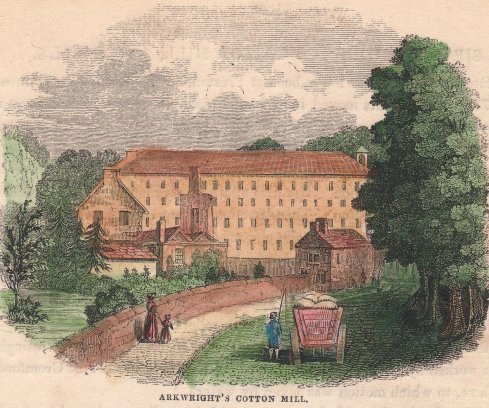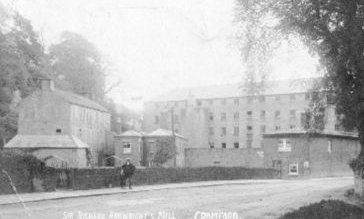Text on rear of above tinted engraving, removed from an [unknown]
early 1800s leatherbound book.
SIR R. ARKWRIGHT'S COTTON MILL, AND CASTLE.
SIR RICHARD ARKWRIGHT was born at Preston, in Lancashire, on December
23rd, 1732. His parents moved in an humble walk of life, and, therefore, it may
be supposed that the amount of school-learning which he received was exceedingly
scanty.
Little is known of the steps by which Arkwright was led to those inventions
that raised him to distinction. His first effort in mechanics was an attempt to
discover the perpetual motion. This direction having been given to his thoughts,
it may naturally be supposed that the circumstances of his living in the midst of
the linen and cotton manufacture, would lead him to consider the possibility of
contriving some machine, by which the disadvantage of slow production might be
overcome; and after much labour and application, he succeeded, in the year 1760,
in obtaining his first patent for spinning with rollers.
The first mill erected for spinning cotton by this method was at Nottingham,
and was worked by horse-power: but, in 1771, he built another at Cromford, in
Derbyshire, to which motion was given by water.
Willersley Castle, the noble home raised with his well-earned wealth, stands on
the south side of a commanding eminence, that forms the eastern boundary of the
Derwent in its course through Matlock Dale: the river flowing at the foot of the
hill, in a grand sweep eastward. The castle consists of an oblong, square building,
with a circular tower rising from the centre of the roof, and a semicircular
tower projecting from the front on each side of the entrance; and two wings, with a
round tower at each angle: the whole structure is embattled, and the exterior
walls are of white freestone.
No man ever better deserved his good fortune, or has a stronger claim on the
respect and gratitude of posterity. His inventions have opened a new and
boundless field of employment; and while they have conferred infinitely more real
benefit on his native country than she could have derived from the absolute
dominion of Mexico and Peru, they have been universally productive of wealth
and enjoyments.
Sir Richard Arkwright died at his Castle at Cromford, August 3rd, 1792, in
the 60th year of his age, leaving a fortune estimated at little short of half a million.
Richard Arkwright, Esq., his son, continued the manufacture established by
his father. In him were blended the high characters of the British manufacturer
and country gentleman: he was much esteemed for his munificence. He died in 1843.
|
Stuart Flint writes:
You may know already how Sir Richard Arkwright built his first Mill
at Cromford, but if not I have the information in my records some of
it taken from the Arkwright Papers which I have access to.
In 1686 Samuel Greensmith and then Andrew and Robert his sons were
partner's with my 6X and 5X Grandfather's William and Thomas Hoades at
Ravenstor Founder Orchard Founder and Ratchwood Mines Colehills and
Rise End Middleton
Samuel Greensmith on the strength of the minerals mined purchased a
Manor House at Steeple Hill (somes known as Steeple House) nr Wirksworth
which was known as Steeple Grange (where the name Steeplegrange gets its
title from) believed to have been purchased from a member of the Blackwall
family which was a gritstone built block stone Manor House with a
Gritstone Walled surround the stone I believe quarried at Bolehill Quarry
near what was known as Stonis or now known as Black Rocks
It is recorded that Robert Greensmith purchased Steeple Grange from Samuel
Greensmith and extended the building in 1714. He was granted a coat of
arms which consisted of 3 pigs of lead and 3 doves argent with an ear of
corn in their bill
In early 1771 Sir Richard Arkwright purchased Steeple Grange from Robert
Greensmith Beard who lived at Stancliffe Hall and then Breadsall Priory..
Sir Richard demolished the estate and used the gritstone blocks to build
his first Mill, which is possibly how he was able to complete the build
within a few months as the stone was already dressed.
The site of Steeple Grange was sold to William Lovett of Matlock New Bath
House with approx 16 acres of land for £630.00 Thorntree House and
24 Steeplegrange are now on the site where the original Grange was built
.. Some of the original masonry is believed to be built into Thorntree
House and the Greensmith Stone was found face down as a paving stone at
24 Steeplegrange. It is now to be seen built into the wall at the
junction of New Road and Steeple Grange Road opposite The War Memorial.
I have a pedigree of the Hoades family of my kin.. My 4XGrandfather Isaac
Hoades married Anne Shaw of Oker near Wensley at St Helens Church Darley
Dale in 1771. Shaws are also my kin via Frosts of my Flint family ..
Isaac ands Anne Hoades dau Betty married George Land of Bolehill whose
daughter Hannah married James Smith of Carsington, Jmes and Hannah's
daughter Sarah married Thomas Cauldwell whose daughter Annie married
John Walker of Bolehill they my Grandparents. he Shaw family of my kin
went on to own Quarries at Matlock, Colehills, Middle Peak and Hoe
Grange nr Longcliffe..
Regards Stuart G Flint
----------
|


 Click on photo for enlargement (on CD only)
Have any more information about this photo?
Please e-mail the author on:
Click on photo for enlargement (on CD only)
Have any more information about this photo?
Please e-mail the author on:


 Click on photo for enlargement (on CD only)
Have any more information about this photo?
Please e-mail the author on:
Click on photo for enlargement (on CD only)
Have any more information about this photo?
Please e-mail the author on:

 Click on photo for enlargement (on CD only)
Have any more information about this photo?
Please e-mail the author on:
Click on photo for enlargement (on CD only)
Have any more information about this photo?
Please e-mail the author on:
